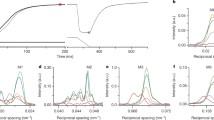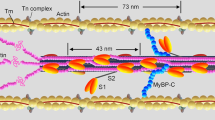Summary
The properties of bi-directional sliding of F-actin prepared from rabbit skeletal muscle moving along clam thick filaments have been characterized in the presence of agents known to modify unloaded shortening velocity in muscle to determine if the sliding characteristics of actin are similar in the two directions of movement. Actin filaments moved at a fast velocity towards the central bare zone (11.1±0.2 μm s-1) and at a slower velocity away from the bare zone (3.9±0.3 μm s-1). Movement of filaments at the slow sliding velocity is thought to be sustained by a change in orientation of the myosin head. The Michaelis Menten constant (Km values) of ∼0.3 mm in the presence of MgATP concentrations of 0.01–2.0 mm at an ionic strength of 43.5 mm were reduced to ∼0.1 mm at low ionic strength (18.5 mm) although the Km values at the fast and slow sliding velocities at each ionic strength were similar. In the presence of constant concentrations of MgATP, increasing the MgADP concentrations from 0.5 to 2 mm, decreased the bi-directional sliding velocity of actin. The data were well fitted with an equation described by Michaelis Menten kinetics yielding mean absolute Km and Ki values of 0.41±0.01 and 0.44±0.05 mm for the fast velocity and 0.29±0.07 and 0.45±0.02 mm for the slow velocity of sliding, respectively. The Km and Ki values were not significantly different from each other at either the fast or slow sliding, velocities. The actin filament sliding velocity appeared to be controlled through the thick filament as actin was devoid of regulatory proteins and the presence of Ca2+ modified the MgATP dependent movement of actin. The pCa value for half maximal sliding velocity was 7.0 for both fast and slow velocities. The Km and Ki values and the Ca2+ sensitivity of the actin movement at the fast and slow sliding velocity are similar suggesting that no major biochemical changes have occurred in the myosin head as a result of a change in orientation.
Similar content being viewed by others
References
BAGSHAWC. R. & SUTCLIFFEM. J. (1994) Another turn for E-F hands. Nature Struct. Biol. 1(4), 209–12.
BRENNERB., SCHOENBERGM., CHALOVICHJ. M., GREENEL. E. & EISENBERGE. (1982) Evidence for cross-bridge attachment in relaxed muscle at low ionic strength. Proc. Natl Acad. Sci. USA 79, 7288–91.
CASTELLANIL. & COHENC. (1987) Myosin rod phosphorylation and the catch state of molluscan muscles. Science 235, 334–47.
CHANTLERP. D. & SZENT-GYÖRGYIA. G. (1980) Regulatory light-chains and scallop myosin: full dissociation, reversibility and co0operative effects. J. Mol. Biol. 138, 473–92.
CHANTLERP. D., SELLERSJ. R. & SZENT-GYÖRGYIA. G. (1981) Cooperativity in scallop myosin. Biochem. 20, 210–16.
COOKER. & PATEE. (1985) The effects of ADP and phosphate on the contraction of muscle fibres. Biophys. J. 48, 789–98.
COOLEYL. B., JOHNSONW. H. & KRAUSES. (1979) Phosphorylation of paramyosin and its possible role in the catch mechanism. J. Biol. Chem. 254, 2195–8.
CRAIGR., SZENT-GYÖRGYIA. G., BEESEL., FLICKERP., VIBERTP. & COHENC. (1980) Electron microscopy of thin filaments decorated with a Ca2+-regulated myosin. J. Mol. Biol. 140, 35–55.
DANTZIGJ. A., HIBBERDM. G., TRENTHAMD. R. & GOLDMANY. E. (1991) Cross-bridge kinetics in the presence of MgADP investigated by photolysis of caged ATP in rabbit psoas fibres. J. Physiol. 432, 639–80.
HARADAY., SAKURADAK., AOKIT., THOMASD. D. & YANAGIDAT. (1990) Mechanochemical coupling in actomyosin energy transduction studied by in vitro movement assay. J. Mol. Biol. 216, 49–68.
ISHIJIMAA., KOJIMAH., HIGUCHIH., HARADAY., FUNATSUT. & YANAGIDAT. (1996) Multiple- and single-molecule analysis of the actomyosin motor by nanometer-piconewton manipulation with a microneedle: Unitary steps and forces. Biophys. J. 70, 383–400.
KNIGHTP. & TRINICKJ. (1984) Structure of the myosin projections on native thick filaments from vertebrate skeletal muscle. J. Mol. Biol. 177, 461–82.
KWONH., GOODWINE. B., NYITRAYL., BERLINERE., O'NEALL-HENNESSEYE., MELANDRIF. D. & SZENT-GYÖRGYIA. G. (1990) Isolation of the regulatory domain of scallop myosin: role of the essential light chain in calcium binding. Proc. Natl Acad. Sci. USA 87, 4771–5.
LEHMANW. & SZENT-GYÖRGYIA. G. (1975) Regulation of muscular contraction. Distribution of actin control and myosin control in the animal kingdom. J. Gen. Physiol. 66, 1–30.
MARSTONS. (1995) Ca2+-dependent protein switches in actomyosin based contractile systems. Int. J. Biochem. Cell Biol. 27(2), 97–108.
NONOMURAY. (1974) Fine structure of the thick filament in molluscan catch muscle. J. Mol. Biol. 88, 445–55.
REEDYM. C., BEALLC. & FYRBERGE. (1989) Formation of reverse rigor chevrons by myosin heads. Nature 339, 481–3.
SELLERSJ. R. & KACHARB. (1990) Polarity and velocity of sliding filaments: control of direction by actin and speed by myosin. Science 249, 406–8.
SELLERSJ. R., SPUDICHJ. A. & SHEETZM. P. (1985) Light chain phosphorylation regulates the movement of smooth muscle myosin on actin filaments. J. Cell Biol. 101, 1897–902.
SIEMANKOWSKIR. F., WISEMANM. O. & WHITEH. D., (1985) ADP dissociation from actomyosin subfragment 1 is sufficiently slow to limit the unloaded shortening velocity in vertebrate muscle. Proc. Natl Acad. Sci. USA 82, 658–62.
SIMMONSR. M. & SZENT-GYÖRGYIA. G. (1985) A mechanical study of regulation in the adductor muscle of the scallop. J. Physiol. 358, 47–64.
SOHMAH., YAZAWAM. & MORITAF. (1985) Phosphorylation of regulatory light chain a (RLC-a) in smooth muscle myosin of scallop, Patinopectin yessoensis. J. Biochem. 98, 569–72.
SPUDICHJ. A. & WATTS. (1971) The regulation of rabbit skeletal muscle contraction. I. Biochemical studies of the interaction of the tropomyosin-troponin complex with actin and the proteolytic fragments of myosin. J. Biol. Chem. 246, 4866–71.
STEPHENSOND. G., WENDTI. R. & FORRESTQ. G. (1981) Non-uniform ion distribution and electrical potentials in sarcoplasmic regions of skeletal muscle. Nature 289, 690–2.
TOYOSHIMAY. Y., TOYOSHIMAC. & SPUDICHJ. (1989) Bi-directional movement of actin filaments along tracks of myosin heads. Nature 341, 154–6.
VALER. D., SZENT-GYÖRGYIA. G. & SHEETZM. P. (1984) Movement of scallop myosin on Nitella actin filaments: regulation by calcium. Proc. Natl Acad. Sci. USA 81, 6775–8.
WEST, J. M., HIGUCHI, H., ISHIJIMA, A. & YANAGIDA, T (1995) Bi-directional sliding movement of actin along native thick filaments isolated from a clam. Proc. Aust. Physiol. Pharm. Soc. 26(1), 96P.
WINKLEMANND. A. & LOWEYS. (1986) Probing myosin head structure with monoclonal antibodies. J. Mol. Biol. 188, 595–612.
XIEX., HARRISOND. H., SCHLICHTINGI., SWEETR. M., KALABOKISV. N., SZENT-GYÖRGYIA. G. & COHENC. (1994) Structure of the regulatory domain of scallop myosin at 2.8 Å resolution. Nature 368, 306–12.
YAMADAA. & TAKAHASHIK. (1992) Sudden increase in speed of an actin filament moving on myosin cross-bridges of ‘mismatched’ polarity observed when its leading end begins to interact with cross-bridges of ‘matched’ polarity. J. Biochem. 111, 676–80.
YAMADAA., ISHIIN. & TAKAHASHIK. (1990) Direction and speed of actin filaments moving along thick filaments isolated from molluscan smooth muscle. J. Biochem. 108, 341–3.
YAMASHITAH., SATAM., SUGIURAS., MONOMURAS., SERIZAWAT. & IIZUKAM. (1994) ADP inhibits the sliding velocity of fluorescent actin filaments on cardiac and skeletal myosins. Circ. Res. 74, 1027–33.
YANAGIDAT., KURANAGAI. & INOUEA. (1982) Interaction of myosin with thin filaments during contraction and relaxation: effect of ionic strength. J. Biochem. 92, 407–12.
Author information
Authors and Affiliations
Rights and permissions
About this article
Cite this article
West, J.M., Higuchi, H., Ishijima, A. et al. Modification of the bi-directional sliding movement of actin filaments along native thick filaments isolated from a clam. J Muscle Res Cell Motil 17, 637–646 (1996). https://doi.org/10.1007/BF00154058
Received:
Revised:
Accepted:
Issue Date:
DOI: https://doi.org/10.1007/BF00154058




